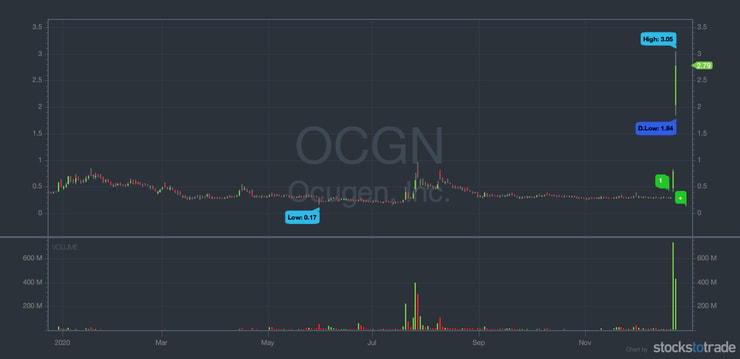I hear this question a lot: What are penny stocks?
That’s usually followed with, “why would you bother trading these junk stocks?”
I get it. You’ll hear a lot of penny stock bashing from big Wall Street traders. And as much as I like penny stocks, I know they’re not for everyone.
I’ve been trading penny stocks for over 20 years now, and have more than $6 million to show for it.*
I only bring up my profits because I want your attention. It takes a lot of hard work to get to where I am. But if you’re interested in getting into trading penny stocks, read on…
What are penny stocks? I’ll explain that here. I’ll also help you understand how to get started with trading. If you put in the time, you’ll learn some strategies for finding a list of the best penny stocks to trade…
(*My results, along with the results of my top students, are far from typical. Most traders lose money. My top students and I have the benefit of many years of hard work and dedication. Trading is inherently risky. Do your due diligence and never risk more than you can afford to lose.)
Table of Contents
- 1 What Are Penny Stocks?
- 2 What Are Penny Stocks … and What’s the Difference Between Penny Stocks and ‘Regular’ Stocks?
- 3 What Are Penny Stocks: The 4 Tiers of Penny Stocks
- 4 Penny Stock Chart Patterns
- 5 How Were Penny Stocks Created?
- 6 The SEC’s Rules for Penny Stocks
- 7 What Are the Risks of Investing in Penny Stocks?
- 8 How Do I Get Started Trading Penny Stocks?
- 9 2 Top Penny Stocks to Watch in 2021
- 10 Is It Possible to Make Money Trading Penny Stocks?
- 11 Trading Challenge
- 12 What Are Penny Stocks: The Bottom Line
What Are Penny Stocks?

The definition of a penny stock is a stock trading for less than $5 per share.
Lots of stocks fall into that category. Some are startups, and some are companies that have fallen on hard times and in danger of going out of business.
Some penny stocks trade on large exchanges like the Nasdaq and the New York Stock Exchange, but the majority trade over the counter (OTC) on markets like the OTC Bulletin Board.
There are a few differences between stocks listed on major stock exchanges and those on the OTC markets, one of the biggest being transparency requirements.
Companies on the Nasdaq have to make certain information public on a regular basis, maintain a share price of at least $1, and disclose certain information to investors. OTC companies don’t have to be as transparent — though they do have to file reports with the Securities and Exchange Commission.
What Are Penny Stocks … and What’s the Difference Between Penny Stocks and ‘Regular’ Stocks?

A lot of people who ask questions like ‘what are penny stocks?’ have a lot of misconceptions about these stocks. Let’s clear up the confusion.
For a trader, a key difference between penny stocks and traditional stocks has to do with volatility.
Exchange-traded stocks generally aren’t very volatile. You typically won’t see insane moves up or down in the same day.
Penny stocks are different. If there’s enough volume, penny stocks can make huge moves in the span of minutes or days. And I mean huge! This can be good if you’re prepared, but bad if you aren’t.
Make sure you do your due diligence and prepare yourself for the volatility…
What Are Penny Stocks: The 4 Tiers of Penny Stocks

Penny stocks are divided into tiers based on their share price ranges. You can decide which tier fits your trading style. Here’s a quick overview…
Tier 1
These stocks trade between $1 and $5 per share. They’re listed on major stock exchanges like the Nasdaq, NYSE, and the American Stock Exchange (AMEX).
Tier 1 penny stocks can be a good starting point for newer traders learning patterns.
Tier 2
These traditional penny stocks trade between a penny and 99 cents. Some trade on major stock exchanges like the Nasdaq but may be in danger of being delisted. Most trade in the OTC markets.
Companies on major exchanges have a certain amount of time to get their share price over $1 or they risk getting delisted to the OTC market.
Companies may take drastic measures to get their stock prices up, which can result in some big moves.
More Breaking News
- Toyota’s Strategic Moves: A Comprehensive Analysis of Latest Developments
- SOBR Stock’s Roller Coaster: An Analysis of Recent Volatility and Key Financials
- Can UMC’s Sustainable Achievements Propel Stock to New Heights?
Tier 3
Tier 3 stocks, or sub-penny stocks, trade … you guessed it … below a penny per share.
I don’t trade sub-penny stocks often. But sometimes I see an opportunity that’s too good to pass up. Learn as much as you can about each tier, so you’re ready if an opportunity presents itself.
Tier 4
Tier 4 stocks are called trip zero stocks. These stocks trade between 0.0001 and 0.0009 cents (triple zeroes) per share. I typically avoid these because they’re extremely illiquid.
Need more on your ‘what are penny stocks’ quest? Read “The Complete Penny Stock Course,” written by Challenge graduate Jamil. It contains all my lessons in one handy book.
Penny Stock Chart Patterns

When I answer a question like ‘what are penny stocks’ — I have to talk about the patterns.
One BIG reason I love penny stocks is because of the chart patterns. They can be predictable.
My go-tos include the morning panic dip buy and the supernova. These patterns seem to be the most predictable, and I think they’re easy to learn if you put in the time.
You might find you prefer other patterns. You do you. And if you want more on the basics so you can build a solid market foundation, get in the 30-Day Bootcamp my top Challenge graduate Matthew Monaco and I put together. It goes over patterns and much, much more.
How Were Penny Stocks Created?
Penny stocks were created in 1934 when the Securities Exchange Act was passed. Since then, penny stocks have had a rocky history, with many days of infamy. Now, after the 2020 market mania, they’re becoming more and more popular with day traders.
I tell my students I consider myself a glorified history teacher. That’s because I study the stock market’s past to prepare myself for the future. History doesn’t repeat itself, but it rhymes…
The SEC’s Rules for Penny Stocks
Penny stock companies aren’t usually as tightly regulated as bigger public companies. But there are some rules. They include:
- The broker-dealer must approve the investor’s transaction and check that the investment is suitable for purchase.
- Also, the broker-dealer must provide a standardized disclosure document that explains risks associated with company fraud.
- The broker must make the investor aware of the funds the broker earns while facilitating the transaction.
Of course, these rules aren’t always followed. That’s why I trade scared and always expect the worst out of every penny stock company.
What Are the Risks of Investing in Penny Stocks?

If you’re asking, “what are penny stocks and can I invest in them?” … read this closely…
First, I trade penny stocks — I don’t invest in them. Penny stocks can be risky. There’s fraud, volatility, halts, and illiquidity in the penny stock market.
I’ve dealt with every one of those at some point or another in my trading career. My biggest loss ever was due to illiquidity. You can read about it in my book, ”An American Hedge Fund.” It’s available to download for free.
Newbies can blow up in this volatile niche. They buy shares of a stock that’s already up big on the day, and when it starts to fall, instead of taking a small loss, they end up bag-holding and hoping that the stock will go back up.
Holding and hoping isn’t a strategy! Don’t get “stuck” in a stock that goes against your plan.
My main rule is to cut losses quickly. It’s rule #1 and the sole thing that can keep you in the game.
You can be meticulous, study the patterns thoroughly, and still see a trade go against you. When that happens, you need to cut losses quickly. Remember that trading isn’t an exact science.
If someone tells you they win 100% of the time, they’re lying. Too many beginning traders get sucked into promoters’ lies and end up losing their hard-earned cash. You can minimize risk if you don’t blindly follow alerts and instead do your due diligence.
That’s worth repeating: Do your research and cut losses quickly any time the trade goes against you…
Everyone seems to complain about the early obstacles, mistakes, losses & how long it takes to become a true expert at whatever subject of your choosing, but did you ever think that all those negative experiences help mold you & allow you to improve BIG in time?! #perspectiveiskey
— Timothy Sykes (@timothysykes) December 22, 2020
How Do I Get Started Trading Penny Stocks?
Here are a few steps to get you started:
- Choose a broker that works for your trading style. Each broker comes with different tools, so finding the best one for you is important.
- Do your research every day to find the best penny stocks for your watchlist. Focus on big percent gainers when starting out.
- Just do it! Don’t make excuses. The best way to get started in penny stock trading is to just do it. You won’t be able to learn the patterns without trial and error.
When it comes to trading penny stocks, it’s all about your dedication. Will you do the work to find the best broker for your individual trading style? How much time will you dedicate every day to building and maintaining a solid watchlist? Will you start trading without making excuses that hold you back?
Here’s the thing … Getting started with penny stocks doesn’t have to be hard. The hard part is staying disciplined and working as hard as you can. You’ll look back one day in awe that you ever asked, “what are penny stocks?”
Now let’s go over some stocks that can teach you some valuable lessons…
2 Top Penny Stocks to Watch in 2021

What are penny stocks to watch in 2021? Here are some former runners that could run again in the new year…
Ocugen, Inc. (NASDAQ: OCGN)
OCGN is a biopharmaceutical company that focuses on developing and commercializing therapies for eye diseases.
Check out the one-year chart…

OCGN had multiple runs in 2020. The most recent run has been huge, and many of my students report trading it well.*
This stock has the potential to run in 2021 because it finished 2020 strong. Keep an eye on it and watch for high volume.
Sunworks Inc. (NASDAQ: SUNW)
SUNW is a solar company that provides photovoltaic-based power systems in California and Nevada.
Take a look at the six-month chart…

SUNW has a similar chart to OCGN. It isn’t ending the year quite as strong, but it’s held its gains very well. Watch for potential breakouts with this stock into 2021.
Is It Possible to Make Money Trading Penny Stocks?

I hope you already know the answer to this question. But if not, the answer is yes!
My $6 million+ in trading profits shows it’s possible.* I’m not the smartest guy in the world. My top students aren’t the smartest people in the world either. We’re just hard workers who’ve put in a lot of time and dedication.
One of my top students turned graduate, Tim Grittani, made over $4 million in profits in 2020 alone.* And he took about four months off to spend time with his family.
Grittani made nothing in his first nine months of trading. The learning process isn’t easy by any means.
I always tell new traders that the first year or two will be the hardest. Don’t come into trading with the money mindset and expect to be an instant millionaire. Trading’s a marathon, not a sprint.
Trading Challenge
I designed my Trading Challenge to help traders become self-sufficient. Being self-sufficient means you don’t have to rely on others to help you with strategies or trades.
The Challenge gives you access to all my DVDs, live webinars, 6,000+ video lessons, and arguably the best trading chat room around.
Not everyone makes it in. I don’t want people who are just looking for hot picks. But if you’re willing to work hard and dig deep so you can become a self-sufficient trader, apply for the Challenge today.
What Are Penny Stocks: The Bottom Line

You’ll hear a lot of bad things about penny stocks. But I love them for day trading. If you take the time to learn how to figure out the right setups that fit you and have the discipline to cut your losses, you might learn to love them too.
Small-cap companies in this niche may double, triple, or even quadruple in a single day. Think about that … Mutual fund managers are considered top-notch if they make 20% on the year.
That’s why I love penny stocks so much. There’s so much potential, and you don’t need a big account to get started.
What do you think about penny stocks? Are you ready to get started trading? Leave a comment below. I love to hear from my readers…




Leave a reply